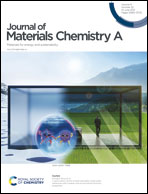{Cu2SiW12O40}@HKUST-1 synthesized by a one-step solution method with efficient bifunctional activity for supercapacitors and the oxygen evolution reaction†
Abstract
The combination of polyoxometalate (POM) and metal–organic framework (MOF) composite materials (POMOFs) is desirable, due to their applications in efficient supercapacitors and electrocatalytic oxygen evolution, but it is still challenging. Herein, we successfully synthesized {Cu2SiW12O40}@HKUST-1 through a one-step solution method. Synergy between {Cu2SiW12O40} and HKUST-1 can promote mass/charge transfer and the adsorption/desorption of intermediates on {Cu2SiW12O40}@HKUST-1. In a three-electrode system, {Cu2SiW12O40}@HKUST-1 as the electrode material has a specific capacitance of 5096.5 F g−1 when the current density is 1 A g−1. After 6000 cycles, the retention rate is 92%, which is much higher than values reported in the literature. A symmetrical electrode assembled with foamed nickel as the current collector has a power density of 510.81 W kg−1 and an energy density of 15.31 W h kg−1, in a 1.0 V voltage window. At the same time, the electrode material in 1.0 M KOH aqueous solution, when the scanning speed is 5 mV s−1, exhibits an overpotential for the electrocatalytic water oxygen evolution reaction (OER) of 340 mV (without iR compensation). Especially at high current densities, {Cu2SiW12O40}@HKUST-1 shows better performance than commercial RuO2. Further, it has excellent catalytic durability. This work provides a basis for the further application of POMOFs.



 Please wait while we load your content...
Please wait while we load your content...